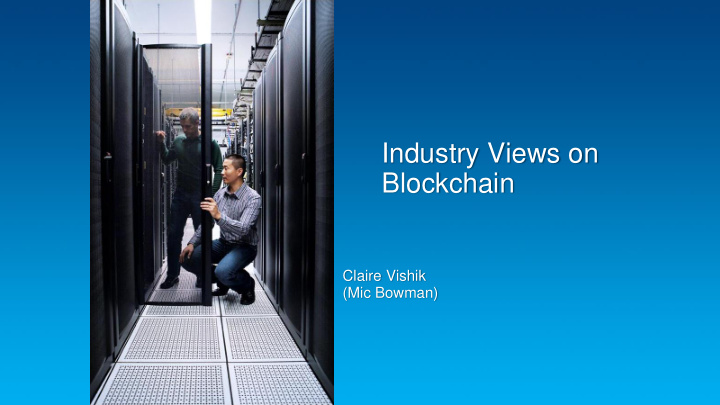



Industry Views on Blockchain Claire Vishik (Mic Bowman)
General perceptions “ Blockchain is the most disruptive invention since the Internet itself” (Digital Doughnut) 2
Modern finance, archaic technology • Internet was a major disruption, but finance was behind – In the US, by 1999, only 20% of the banks were offering online banking • Even now, post-trade reconciliation and settlement takes 3-30 days – And still involves exchanging spreadsheets sometimes • Finance didn’t anticipate blockchain – In 2014, issues such as mobile check capture and branch optimization were recognized as key priorities in finance surveys 3
Blockchain expansion • Both threat and opportunity for finance • Applications available in – E-Government – Real Estate – Enterprise – IoT – Storage – Identity – Many more • Startup space is very active – E.g., Nexus labs have a database of 300 early stage startups in Europe • The number of events is growing – Several in The Hague area only in the course of the next two weeks 4
Distributed Ledger Technology In One Slide Summary Distributed Ledger Technology, or DLT, is a set of communication protocols that enable administratively decentralized, replicated databases. It is currently being used as the basis for crypto-currencies. Initial alternative usages are being explored in financial services, around clearing and settlement. DLT is useful today, but potentially, DLT as a common protocol COULD have widely transformational impact. It would enable any trusted, decentralized transactions and transform all online transactions, although significant barriers to these usages remain. DLT Today Is Still Being Worked Out: The Upside Potential Is Substantial, But Untested • • There are too many unanswered questions about In financial services alone, cost reduction for pre- and validation mechanisms, scalability of transactions, post-trade settlement; syndicate lending could be very complexity of transactions, number of participants, substantial. Instant auditability could improve many viability of privacy, and more. processes. In e-government, the same practices could be broadly applied. DLT Today Is Immature for Enterprise: • Industry is looking at a wide range of applications No service level agreements, transaction rates are too slow, anonymity is uncontrolled, endpoints are insecure, Considering security, privacy, scalability, and standards, validation is (computationally or network-load) but the work is in its early stages.. inefficient. And useful applications are still emerging. 5
So, why is industry ICT industry interested in blockchain? • A disruptive technology & model • Potentially broadly applicable (e.g., database replication) • Potentially enabling new services and use cases • Potentially a foundational technology • Many similar reasons 6
So, what is out there? • Cryptocurrency exchanges – E.g., Polonex, Coinbase, Coinsetter • Brokerage services – E.g, Volobit, Unocoin, Coinjar • Software wallets – E.g, Xapo, Coinkite, Coinprism • Hardware wallets – E.g., CASE, Keep Key • Microtransactions solutions – E.g., ProTip, ChangeTip 7
So, what is out there II? • Investments, loans – E.g., BitBond, Loanbase, Magnr • Money (remittances) ervices – E.g, CoinX, ABRA, CryptoPay • Capital markets – E.g, Chain, Clearmatics • Trading platforms – E.g., orderBook, Mirror • Merchant Services – E.g., CoinSimple, Pagos 8
So, what is out there III? • Compliance tools • ATM • Financial Data • Payroll & insurance • And a lot of work outside of the financial sector… 9
MODULAR DEVELOPMENT & TESTING: SAWTOOTH LAKE
Disclaimer • Sawtooth Lake is a research project… – Rapid prototyping of new concepts (consensus, transactions, etc) – Measure “big O” performance of large deployments – Experiment with architectures and layering – Extensible, plug-and- play, … • It is not… – Production quality… though we are in the process of hardening it – Optimized for validator performance • And… we have found it useful for building interesting applications 11
Code • The code is open sourced in NTG … code available here: • https://github.com/intelledger • Docs here: • http://intelledger.github.io/ • 12
Sawtooth Lake Architecture Ledger Define and enforce semantics for transaction families Journal Drive global consensus on an ordering of transaction ids Communication Facilitate communication between nodes 13
Sawtooth Lake Validator Ledger Gossip protocols for inter-validator Endpoint Distributed communication Registry Marketplace Journal Consensus Protocol HTTP interface for light clients Observer Communication HTTP Gossip Endpoint Endpoint Transactor 14
More On The Journal Validation Incentive Up-Call Up-Call Journal Commit Handle Consensus Block Disputes Protocol Claim Construct Block Block The consensus abstraction allows plug and play of both lottery and voting consensus protocols 15
More On The Ledger Distributed Marketplace Ledger Cached State Endpoint Distributed Registry Marketplace Txn Incentives Validation Transaction families capture the semantics of a transaction and enforce compliance with the semantics 16
Distributed Marketplace Transaction Family • Basic objects • Transactions – Participant (the “who”) – Register each kind of object – Assets (the “what”) – Exchange ownership of objects – Holdings (“who” owns “what”) • And one more… – Offers to exchange A Concrete Application for Testing Hypotheses About Application Viability and Value 17
Example: Football Exchange A Marketplace Game Based on Trading Shares of Football Teams • The league creates within the • The league gives new contestants an initial set of team shares and Marketplace: some currency – assets for shares of each team and • Contestants may sell or trade shares the game currency “ mikels ” with the league or with other players – buyback offers for team shares • Contestant with the most currency at equivalent to the points the team scores in games it wins the end wins The Marketplace Is General Enough To Exchange Arbitrary Value 18
Status • Implemented in Python • Network Topologies – Crypto acceleration in C/C++ – Random Walk – JSON/CBOR message encoding – Barablisi-Albert (scale-free) – Emulated SGX support – NOTE: “Real” SGX enclaves • Consensus Protocols distributed separately – Proof of Processor (SGX) – Federated, Quorum-Voting • Scale Tests – Mean commit time/rate • Transaction Families – Transaction rates – Endpoint Registry (configuration) – Number of validators – IntegerKey (scale tests) – Network drop rates/latency – Digital Marketplace 19
Recommend
More recommend